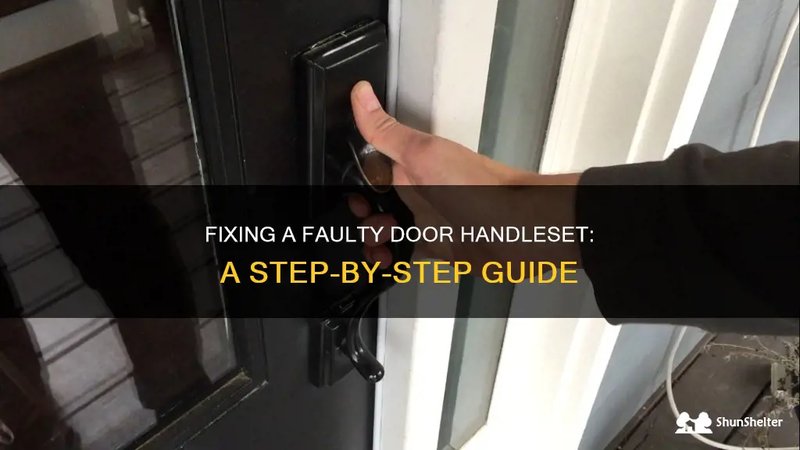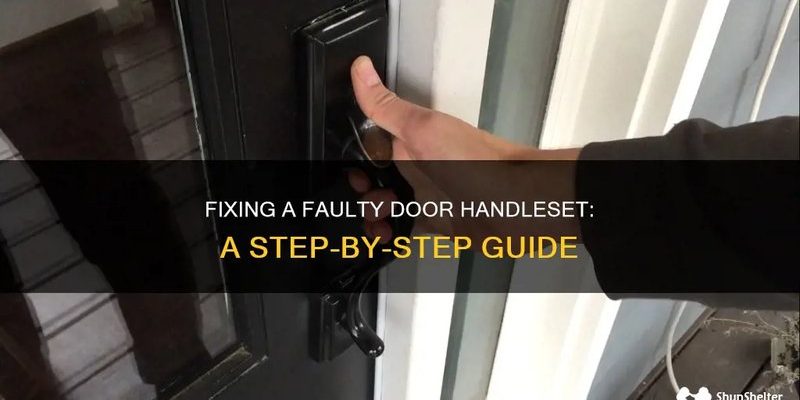
Honestly, dealing with a handleset that’s binding because of paint buildup can turn a five-second door-opening routine into a wrestling match. But you don’t need to be a locksmith or a DIY pro to fix it. With a little patience and the right approach, you can get your handleset back to smooth, easy operation—and maybe learn something about troubleshooting along the way. Let me walk you through it, from figuring out what’s really causing the problem to getting every part moving like new again.
How Paint Buildup Causes a Handleset to Bind
Here’s the thing: handlesets are designed with precise tolerances. Every moving part, from the latch bolt to the handle spindle, needs room to move freely. But when you slap on fresh coats of paint over the years, paint can seep into the cracks, fill in those tiny gaps, and start to harden. Over time, that paint buildup acts like a wedge, squeezing the metal parts and jamming up the works.
You might notice this after a recent paint job, or it could creep up as layer upon layer accumulates. It’s especially common with popular brands like Schlage or Kwikset, since their handlesets often have decorative plates and trims that catch extra drips. Sometimes, even the latch itself can be painted shut, making it almost impossible to retract.
You might be wondering if this is really your problem, or if there’s something wrong with the lock code, sync, reset, or battery (with electronic models). But when your lock starts sticking right after painting or feels gritty and stiff, paint is a likely suspect. This kind of troubleshooting comes down to a close look and a careful touch.
Signs Your Handleset Is Binding Because of Paint
Before you reach for the screwdriver, it’s smart to confirm that paint is the troublemaker. Here are a few things to watch for:
- Handleset feels stiff or stuck. If you have to use extra muscle to turn or push the handle, that’s a classic sign.
- Visible paint around the edges. Look closely at the plates or latch. If you see thick or crusty paint bridging the gaps, it’s probably interfering.
- Latching and unlatching is rough. You might hear a scraping noise, or the latch won’t spring back like it should.
- Key won’t turn smoothly. Even with a fresh battery or after a lock code reset, paint can slow down the lock cylinder itself.
Here’s a quick test: run your fingernail around the edges of the handleset. If you can feel hardened ridges or flaky bits, you’ve found your culprit. Sometimes, the paint even sneaks inside the latch mechanism, especially if the door was painted without removing the hardware.
Tools You’ll Need for the Repair
You really don’t need a full toolkit or fancy gadgets. Most beginners can handle this repair with a handful of simple tools and a little patience. Here’s what I recommend:
- Small flathead screwdriver or utility knife — for scraping away dried paint
- Painter’s multi-tool or putty knife — helpful for gently prying up thick layers
- Old toothbrush or stiff-bristle brush — for cleaning out debris and dust
- Lubricant spray (like WD-40 or graphite) — to help the handleset move smoothly again
- Soft cloth — for wiping away dust and grease
- Phillips screwdriver — in case you need to fully remove the handleset
If your handleset also has electronic parts (like a keypad or smart lock with battery), you’ll want to be gentle and avoid getting moisture or lubricant on the electronics. Removing the battery before cleaning is always a good idea.
Step-By-Step: How to Remove Paint Buildup from a Handleset
Let me explain how to tackle the repair without damaging your door or hardware. The goal is to restore smooth motion, not scratch up the finish or bend anything out of shape.
- Inspect and Test: Look at where the handleset is binding. Try operating the handle, thumb latch, and key. Notice exactly where it feels stuck.
- Score the Edges: Using a utility knife or a small flathead screwdriver, gently score along the edge where the hardware meets the paint. This breaks the seal and prevents peeling or tearing up the door finish.
- Remove Visible Paint: Use your tool to carefully flake off dried paint around the handleset and latch. Be patient—work slowly so you don’t gouge the hardware or damage the door.
- Clean Out the Gaps: Brush away dust and paint chips with a stiff-bristle brush or toothbrush. This helps free up the moving parts.
- Test the Motion: See if things are already moving more freely. If the handleset is still binding, you may need to remove it to clean underneath.
- Remove the Handleset (If Needed): With a Phillips screwdriver, carefully remove the handleset from the door. Check for paint buildup on the back side, latch bolt, and internal parts.
- Deep Clean and Lubricate: Scrape away stubborn paint inside the mounting holes. Wipe everything with a cloth. Apply a little lubricant to the moving parts before re-installing.
- Reinstall and Test: Put the handleset back in place. Tighten the screws, then check for smooth, easy operation.
Take your time. The most common mistake is getting impatient and scratching the handleset or door. A little extra care goes a long way.
When to Replace vs. Repair a Paint-Bound Handleset
You might be wondering if it’s just easier to replace the whole handleset. Here’s my honest take: most of the time, you can save it with some careful cleaning. If you’re dealing with a solid brand like Schlage, Kwikset, or Yale, these handlesets are built to last. Unless the mechanism is deeply corroded or parts are bent out of shape, repair is usually the smarter, cheaper move.
But if the paint has totally gummed up the internals, or the key cylinder is ruined, a replacement could be faster. The same goes for certain smart locks—if battery leakage or paint has fried the electronics, it might not be worth the trouble. But in most cases, cleaning out the paint and giving things a quick reset will get you back to working order.
If you’re tempted to swap for a universal handleset, just keep in mind that fit and finish may vary. Sticking with your original brand usually means better compatibility and a smoother repair.
How to Prevent Handleset Binding After Painting
After wrestling with a painted-shut handleset once, trust me—you’ll never want to deal with it again. Simple prep makes all the difference. Next time you paint your door, take a few extra minutes for protection:
- Remove the handleset before painting. It’s the best way to avoid paint in the mechanism and gaps. It only takes a screwdriver and a few minutes.
- Use painter’s tape around the hardware. If removing isn’t possible, carefully tape off metal parts and seams. Press the tape tight to prevent seepage.
- Keep paint light and controlled. Don’t let thick paint pool or form ridges around the handleset. A little patience and a steady hand pay off.
- Let everything dry fully before reinstalling hardware. Wet paint acts like glue and can trap the handleset in place.
A little prevention saves a lot of troubleshooting and repair work in the future. Handle these details once and you’ll avoid the headache next time.
Common Mistakes to Avoid When Cleaning Paint from a Handleset
Honestly, I’ve seen plenty of well-meaning DIYers make things worse when trying to fix a binding handleset. Here’s what to steer clear of:
- Using harsh chemicals or paint strippers. These can ruin finishes, melt plastic parts, or even damage electronics in a smart lock.
- Forcing the handle or latch. If it’s stuck, don’t use brute strength. That’s a great way to bend internal parts or snap something.
- Skipping the lubricant. Clean hardware without lubrication can wear out faster and start sticking again soon after.
- Not checking the alignment. Sometimes, things still feel off because the handleset wasn’t reinstalled straight—take your time to align everything before tightening.
If you mess up the finish or scratch the handleset, a little touch-up paint (carefully applied) can help. Just be sure not to repeat the same paint buildup mistake!
When to Call a Locksmith or Professional
Sometimes, even with the best troubleshooting, you can’t get a handleset working smoothly. Maybe screws are stripped, the mechanism is rusted, or you’re worried about damaging an expensive electronic remote or smart lock. That’s when it’s smart to step back and call a pro.
Locksmiths deal with this kind of issue all the time—paint buildup, jammed parts, and even failed code syncs or resets. They’ll have the right tools and know-how to clean things up without scratching or wrecking your hardware. Plus, if parts need replacing, they can size up what works best for your specific setup and door.
If you’re up for a DIY project, great! But there’s no shame in getting expert help, especially with high-end brands or smart features tied to your home’s security.
Wrapping Up: Enjoying Smooth Handleset Operation Again
Paint buildup might seem harmless, but it can turn your entryway into a daily frustration. The good news? With a simple step-by-step approach, you can rescue almost any binding handleset and get that easy, satisfying click again. Whether you’re dealing with a classic Schlage, Kwikset, or even a Yale smart lock, a careful repair and a little troubleshooting go a long way.
Next time you tackle a paint job, remember the care you put in today prevents the hassle down the road. And if you ever need a reset, a battery swap, or a quick realignment, you’ll know exactly what to do. Here’s to doors that open like they’re supposed to—and never put up a fight.
